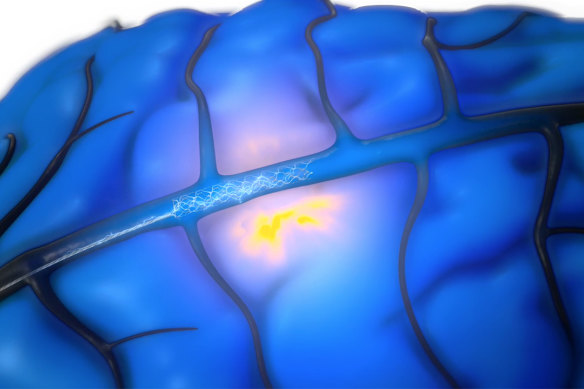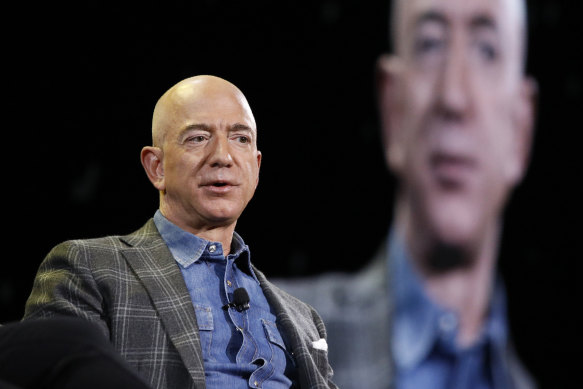[ad_1]
Its technology is very similar to Neuralink. However, unlike Musk's chip, Synchron's technology does not require the patient to undergo a complex surgery using a high-tech robot in a private clinic.
Instead, its technology is based on a decades-old invention in the form of a stent — typically used to treat heart disease. This technique uses a hollow tube that is inserted into an artery or vein, which can then be used as a pathway.
Synchron's Stentrode microchip is pushed through a blood vessel and into the patient's brain via a catheter — where it can begin to pick up brain waves.
Oxley, a neurointerventionalist at Mount Sinai Hospital in New York, says Synchron's simpler technology could see it expand “globally over the next couple of years” if it passes critical upcoming trials.
“To achieve scale, what we don't have to do — which companies like Neuralink need to do — is build robots in surgical centers that can achieve that,” says Oxley, who is based in New York and Australia. .
Synchron's rationale is that it can reach many more patients with its simple technology than a company that requires brain surgery. Its less invasive form of brain transplantation has captured the imagination of Silicon Valley — and attracted money from Musk's rivals. Synchron has raised more than US$140 million ($212.8 million) from investors including Jeff Bezos and Bill Gates.
Oxley began his career as a paramedic. His friend and co-founder Rahul Sharma worked in “the glamorous part of medicine” – cardiology. On the other hand, Oxley “fell in love with the brain.”

Synchron's Stentrode microchip is pushed through a blood vessel and into the patient's brain via a catheter — where it can begin to pick up brain waves.credit: synchronization
Scientists have been exploring whether it is possible to connect computers to the human brain for the past two decades, but only in the past few years have advances in surgical techniques, smaller microchips, and more advanced smartphones and tablets allowed brain-to-brain interfaces (BCIs) to become common. possible possibility. .
Oxley had envisioned synchronization long before Musk's endeavor was launched in 2016. He came up with the idea of implanting a chip using a stent while at the University of Melbourne in the late 2000s, and pitched the idea to DARPA, the US military's research division, in a Cool in 2010. The innovation agency, which had been instrumental in developing new technologies like GPS, jumped on the idea, providing early capital.
After years of research, Oxley gave a TED Talk to rapturous reception in 2017, capturing the attention of Silicon Valley. The 2022 funding round brought in heavyweight investors, including Bezos Expeditions, the Gates Foundation and Indian billionaire Mukesh Ambani's Reliance Foundation.
Synchron's brain chip is able to pick up signals that allow the operator to use an iPhone or iPad in its accessibility mode, which is designed for people with disabilities.
“We take for granted how important these devices are in our lives,” Oxley says.
“Things like texting, email, banking, shopping, getting health care all happen over the phone.”
“There are a large number of conditions that can prevent you from being able to use your phone, stroke, amyotrophic lateral sclerosis,” he adds. [motor neurone disease]Spinal cord injury.”
Oxley believes Synchron's technology will be able to reach more patients more quickly than surgery-based competitors.
“We think we're moving faster along the clinical and regulatory timeline because we have decades of history behind us in terms of technology that enters the body using blood vessels,” he says.

Jeff Bezos is a high-profile investor in Synchron. credit: AP
However, there are theoretical disadvantages to using a stent versus delivering devices directly to the brain. With the stent chip placed in a blood vessel, there is more “noise” that makes it difficult to read signals from the brain.
For example, Sync Jockey can't capture detailed movement like a mouse moving across the screen, for example. “It's a trade-off,” Oxley admits.
However, he believes the device will still be revolutionary because it will allow access to phone features that millions do not currently have access to.
The field of BCI is advancing rapidly. Last year, a paralyzed Dutch man, Geert Jan Oskamm, was able to walk again after implants were placed in his brain and spine. He was paralyzed in a bicycle accident over 12 years ago. The British government's Aria Laboratory is also exploring whether these chips will soon be ready for widespread adoption. Neuralink's success with Arbo, its first patient, clearly represents a landmark moment for this emerging technology. But what about Musk's more outlandish claims about telepathic brainwaves or AI symbiosis? Do these prophecies help or hinder our most pressing health care goals?
“I don't think that necessarily helps,” Oxley says.
“That's not why we came into business and I don't think the concept that we need to integrate with computers is what's driving the need for BCI to become a reality.
“On the other hand, I think this technology is at the beginning of the journey – this is overcoming the inherent limitations of how our bodies interact with our brains.”
download
As brain chips advance, people may soon be able to “share their inner experiences in a way that is not possible with their bodies,” he adds, noting that with this will come a host of questions about data privacy and who has access to our deepest inner selves. ideas.
Synchronization still has to prove the strength of its technology. In 2020, she demonstrated how her supports can translate thoughts into actions on a computer screen with motor neuron patient Philip O'Keefe. It is now in trials with the US Federal Drug Administration, and is working on a manufacturing process to mass produce the stents.
“We had to develop a completely new manufacturing technology,” says Oxley.
To get to the next stage, Synchron needs more money. “We have a significant amount of money that we need to raise to get this done and we will be raising other funds in the near future,” Oxley says.
The startup's technology has already been implanted in 10 patients in trials across the United States and Australia. Its next trial could include dozens of patients.
“It's not as fast as what you can do with your hands, but it's life-changing for people who have lost the ability to use their hands at all,” Oxley says.
The Business Briefing newsletter delivers key news, exclusive coverage and expert opinions. Sign up to receive it every weekday morning.
[ad_2]
Source

